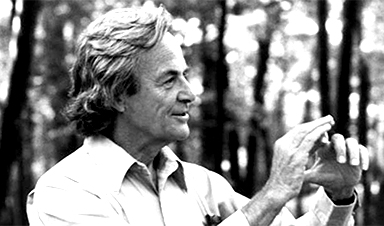 Richard Feynman gave his famous talk “There’s Plenty of Room at the Bottom” (Original Transcript Available Here : http://muonray.blogspot.ie/2012/12/ri…) on December 29th 1959 at the annual meeting of the American Physical Society at the California Institute of Technology (Caltech) as his vision on how physics and engineering could move in the direction that could eventually create nanotechnology.
Richard Feynman gave his famous talk “There’s Plenty of Room at the Bottom” (Original Transcript Available Here : http://muonray.blogspot.ie/2012/12/ri…) on December 29th 1959 at the annual meeting of the American Physical Society at the California Institute of Technology (Caltech) as his vision on how physics and engineering could move in the direction that could eventually create nanotechnology.
Really good ideas and strokes of genius are often manifest in the right questions being asked: How small can information be encoded? How can information be written? How can information it be read? All of these important “Hows” were asked by Feynman in a time when computers had to be put in large rooms and when the impending space race was forcing engineers to do some serious strategic thinking in making technology small enough to be lifted by rockets into space to function as serious tools in scientific exploration and defence.
Feynman himself may not have invented the technology we see in the development and continuity of the computer age, but the fact that even in the early 1960’s nanotechnology was being considered as a serious field of study was definitely a factor contributing to the boom in computer technology seen in the late 20th century and continues to reach more spectacular levels of sophistication in the 21st century.
Jump 25 years forward into the year 1984, when Feynman tries to retell his 1959 lecture from a more modern perspective in that many aspects of his vision have been fulfilled, particularly with the invention of the electron microscope, the atomic force microscope and experimental manipulation of the atomic scale of matter. Also discussed is the current practical field of photolithography for the manufacture of bipolar transistors and junctions used in computer chips done on an industrial scale and how this process continues with ever decreasing wavelength capabilities of lasers from UV to X-rays.
Feynman also discusses the boundaries of miniaturization and how the scale differences affect the function of certain aspects of technology as well as in nature. In the true spirit of Feynman, the discussion goes into the colorful details and gives diagrammatic examples of how this field had progressed from 1959 to 1984.
We can only imagine how Feynman would have felt about the modern developments in nanotechnology in the 21st century where entirely exotic principles of physics may begin to become technologically significant, including vacuum fluctuations and quantum entanglements. Without a doubt he would have found our developments exciting but always within the realms of understanding by studying the most fundamental language of nature, quantum mechanics, to bring our macroscopic brains into visualizing, however abstractly, the tiny machinery of nature.
Image Credit: Shutterstock.com
News This Week
The Brain’s Strange Way of Computing Could Explain Consciousness
Consciousness may emerge not from code, but from the way living brains physically compute. Discussions about consciousness often stall between two deeply rooted viewpoints. One is computational functionalism, which holds that cognition can be [...]
First breathing ‘lung-on-chip’ developed using genetically identical cells
Researchers at the Francis Crick Institute and AlveoliX have developed the first human lung-on-chip model using stem cells taken from only one person. These chips simulate breathing motions and lung disease in an individual, [...]
Cell Membranes May Act Like Tiny Power Generators
Living cells may generate electricity through the natural motion of their membranes. These fast electrical signals could play a role in how cells communicate and sense their surroundings. Scientists have proposed a new theoretical [...]
This Viral RNA Structure Could Lead to a Universal Antiviral Drug
Researchers identify a shared RNA-protein interaction that could lead to broad-spectrum antiviral treatments for enteroviruses. A new study from the University of Maryland, Baltimore County (UMBC), published in Nature Communications, explains how enteroviruses begin reproducing [...]
New study suggests a way to rejuvenate the immune system
Stimulating the liver to produce some of the signals of the thymus can reverse age-related declines in T-cell populations and enhance response to vaccination. As people age, their immune system function declines. T cell [...]
Nerve Damage Can Disrupt Immunity Across the Entire Body
A single nerve injury can quietly reshape the immune system across the entire body. Preclinical research from McGill University suggests that nerve injuries may lead to long-lasting changes in the immune system, and these [...]
Fake Science Is Growing Faster Than Legitimate Research, New Study Warns
New research reveals organized networks linking paper mills, intermediaries, and compromised academic journals Organized scientific fraud is becoming increasingly common, ranging from fabricated research to the buying and selling of authorship and citations, according [...]
Scientists Unlock a New Way to Hear the Brain’s Hidden Language
Scientists can finally hear the brain’s quietest messages—unlocking the hidden code behind how neurons think, decide, and remember. Scientists have created a new protein that can capture the incoming chemical signals received by brain [...]














Leave A Comment